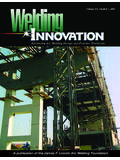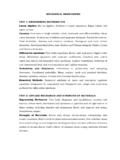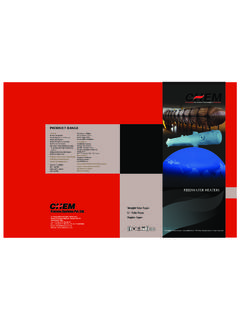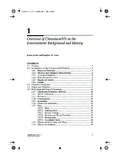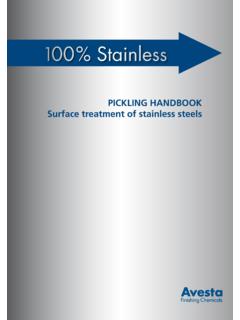Transcription of Explosives - feem.info
1 Explosives Jacques Boileau Claude Fauquignon Bernard Hueber Hans Meyer 1 Consultant, Paris, France 2 ISL Institut Franco-Allemand de Recherches de Saint-Louis, Saint-Louis, France 3 Nobel Explosifs, Paris, France The article contains sections titled: 1. Introduction 2. Physical Properties and Chemical Reactions Detonation Ideal Detonation Deflagration and Detonation Prediction of Detonation Data Complete Calculation Approximation Methods Nonideal Detonation Waves and Explosives Nonideal Explosive Compositions Detonation of Cylindrical Cartridges Low- and High-Order Detonation Velocity The Effect of Confinement The Buildup of Detonation Combustion - Deflagration - Detonation Transition (DDT) Shock-to-Detonation Transition (SDT) Shock and Impact Sensitivity Classification of Explosives Functional Groups Nitro Group Other Groups 3.
2 Application Energy Transfer from the Explosive to the Surroundings Shock and Blast Waves Casing and Liner Acceleration High Compression of Solids Metal Forming and Welding Rock Blasting Perforators, Shaped or Hollow Charges 4. Primary Explosives 5. Secondary Explosives Production Specific Secondary Explosives Nitrate Esters Aromatic Nitro Compounds N-Nitro Derivatives 6. High Explosive Mixtures Desensitized Explosives TNT Mixtures Plastic-Bonded Explosives (PBX) 7. Industrial Explosives Dynamites Ammonium Nitrate Explosives Ammonium Nitrate - Fuel Oil Explosives Slurries and Water Gels Explosive Emulsions Uses 8. Test Methods Performance Tests Safety 9. Legal Aspects and Production Safety Regulations Production of Military Explosives 10. Toxicology and Occupational Health 1 Introduction An explosion is a physical or chemical phenomenon in which energy is released in a very short time, usually accompanied by formation and vigorous expansion of a very large volume of hot gas: 1.
3 Mechanical explosions are caused by the sudden breaking of a vessel containing gas under pressure 2. Chemical explosions are caused by decomposition or very rapid reaction of a product or a mixture 3. Nuclear explosions are caused by fission or fusion of atomic nuclei 4. Electrical explosions are caused by sudden strong electrical currents that volatilize metal wire (exploding wire) 5. Astronomical explosions are caused by solar flare activities on most stars. 6. Natural explosions are caused by volcanic eruptions when dissolved gas in the magma evaporates resulting in a rapid increase in volume. Only chemical explosions are treated in this article. For an explosion to occur, the reaction must be exothermic; a large amount of gas must be produced by the chemical reaction and vaporization of products; and the reaction must propagate very fast.
4 For example, gasoline in air burns at a rate of ca. 10 6 m/s; a solid propellant, at ca. 10 2 m/s; and an explosive detonates at a rate of ca. 103 104 m/s (detonation velocity). The two different modes of decomposition are deflagration and detonation. Deflagration exhibits two characteristics: 1) the combustion is very rapid (1 m/s up to a few hundred meters per second) and 2) the combustion rate increases with pressure and exceeds the speed of sound in the gaseous environment, but does not exceed the speed of sound in the burning solid. The materials are often powdered or granular, as with certain pyrotechnics and black powder. Detonation is chemically the same as deflagration, but is characterized by a shock wave formed within the decomposing product and transmitted perpendicularly to the decomposition surface at a very high velocity (several thousand meters per second) independent of the surrounding pressure (see Chap.
5 2). Explosive substances can be divided into three classes. Members of the first class detonate accidentally under certain conditions. These are explosible substances, some of which are used in industry as catalysts ( , peroxides), dyes, and fertilizers. This class includes products or mixtures whose formation must be avoided or controlled, , firedamp, or peroxides in ethers. In the second class are products normally used for their quick burning properties but which may detonate under some circumstances, , pyrotechnic compositions, propellants, and some kinds of hunting powder. In the third class are substances intentionally detonated for various purposes. For reasons of safety, acquaintance with the first group of materials is necessary. The second group is described elsewhere ( Propellants; Pyrotechnics). Pure substances and mixtures of the third class are described here.
6 The distinctions between these three classes are not clear-cut because most Explosives burn smoothly if they are not confined. However, if some fine hunting powder burns under certain confined conditions, combustion may become detonation. Dry nitrocellulose fibers can easily detonate, but this tendency is significantly lower in the gelatinized form. Some compositions, such as mixtures of cyclotrimethylenetrinitramine (RDX) with a binder, can be used as a propellant, gunpowder, or high explosive, depending on the type of initiation. The third class consists of primary and secondary Explosives . Primary Explosives like lead azide (initiator Explosives ) detonate following weak external stimuli, such as percussion, friction, or electrical or light energy. Secondary Explosives such as Pentaerythrittetranitrate (PETN) or N-Methyl-N-2,4,6-tetranitroanilin (Tetryl) are much less sensitive to shock.
7 However, they can detonate under a strong stimulus, such as a shock wave produced by a primary explosive, which may be reinforced by a booster composed of a more sensitive secondary explosive. The various secondary Explosives are used militarily or industrially as shown in Figure 1. Functions and Constraints. Explosives can be either pure substances or mixtures. They function in such systems as munitions, where they are a component of a complex firing system or as firing devices in mining, quarries, demolition, seismic exploration or metal forming equipment. With such systems, the ingredients must fulfill one or more functions, while meeting various constraints arising in manufacture or use. Therefore, tests that represent these functions and constraints are required. When an explosive detonates, it generates a shock wave, which may initiate less sensitive Explosives , cause destruction (shell fragments, blast effect, or depression effect), split rocks and soils, or cause formation of a detonation wave.
8 A detonation wave of special geometry (hollow charge effect) may modify materials by very rapid generation of high pressure; for example, shaped charges, metal hardening, metal-powder compaction, or transformation of crystalline forms. Shaped charges can be applied for the destruction and demolition of large obsolete structures by causing an inward collapse. Shaped charges (so-called perforators) are also used in the exploitation of petroleum and natural gas wells by perforating the metal casing of the well thus allowing the influx of oil and gas. A shock wave may be used to transmit signals, , for safety devices or in seismic prospecting. In general, constraints are related to safety, security, stability, compatibility with other elements of the system, vulnerability, toxicity, economics, and, more recently, environmental and disposal problems [21].
9 History [1,4,88]. Explosives were probably first used in fireworks and incendiary devices. The admixture of saltpeter with combustible products such as coal and sulfur produced black powder, already known in China in the 4th century , described in 808 by Qing-Xu-Zi, and used as a military gunpowder in a book published in 1044. The use in shells during the Mongolian wars around 1270 and a severe explosion in a factory in 1280 were described. The first correct description of the phenomenon of shock waves in air seems to be in a book by the scientist Song-Ying-Xing in 1637. Around 1580 first descriptions in Europe are known (siege of Berg-op Zoom). However, the difficulties of initiation upon impact against the target were not overcome until 1820 when fulminate caps were developed. In the early 1600s, black powder was used for the first time to break up rocks in a mine in Bohemia.
10 This technique spread throughout Wwestern Europe during the 1600s. Ammonium Perchlorate was discovered in 1832. The development of organic chemistry after 1830 led to new products, although their explosive properties were not always immediately recognized. These include nitrocellulose and nitroglycerin. The very important contributions of ALFRED NOBEL (1833 1896) include the use of mercury fulminate in blasting caps for the safe initiation of Explosives (1859 1861), the development of dynamites (by chance Alfred Nobel found that when Nitroglycerin was mixed in a ratio of 3:1 with an absorbent inert substance like Kieselguhr (diatomaceous earth) it became safer and more convenient to handle, and this mixture was patented in 1867 as Dynamit ), and the addition of 8 % nitrocellulose (gun cotton) to nitroglycerin ( Gelignite or blasting gelatine, 1876).

